What Plants Are The Easiest to Take Care of?
- horticulturist and gardening expertMay 4, 2024
We all want beautiful gardens that require minimal maintenance. I am often asked for a list of no maintenance plants that provide season-long beauty and I’m always sorry to disappoint those that ask. It is necessary for us to invest some time and effort when caring for any living organisms including plants that must contend with the weather and the often less-than-ideal growing conditions. There are ways, however, that you can minimize the effort needed by selecting the right plants and adjusting your landscape design.
Less is More in the Garden
Just as the minimalist movement considers less is more, so can you when designing your gardens. Use fewer species but a diverse palette of plants. This reduces the risk of a disease or insect pest wiping out whole plantings like Emerald Ash borer and Dutch Elm Disease have done to our landscapes and natural areas.
I heard similar advice from a perennial garden designer speaking to a group of plant enthusiasts. She recommended that once you design your garden, cut the number of species in half and double the number of each. The greater quantity of each will create a greater impact, and the fewer species will help reduce maintenance. As you make such changes, be sure your design still provides seasonal color, form, and texture. Including plants with multiple seasons of interest extends the beauty each plant provides, allowing greater impact from fewer plants. Look for those with colorful foliage, flowers, fall color, and interesting seed pods or berries.
Select low-maintenance plants that are not aggressive or invasive. This will save you time and effort needed to manage or remove plants that take over your landscape and nearby natural spaces. Avoid plants that require regular removal of faded flowers, deadheading, to look their best, continue flowering or to prevent them from creating an overabundance of offspring. Further reduce maintenance by growing the most insect pest and disease resistant plants suited to your growing conditions.
Easy to Care for Annual Flowers
You will need to replace annual flowers each year, but their season-long blooms help fill voids in the garden, add pollinator appeal, and lift our spirits. Here are just a few to consider:
-Zinnias seem to have made a comeback and it is no surprise as they are great for full sun, hot and dry locations once established. Select disease resistant varieties like the Profusion and Zaharaâ series. Single flowered varieties are the most attractive to pollinators and you might even find a hummingbird visiting the blooms and songbirds nibbling on the seeds.
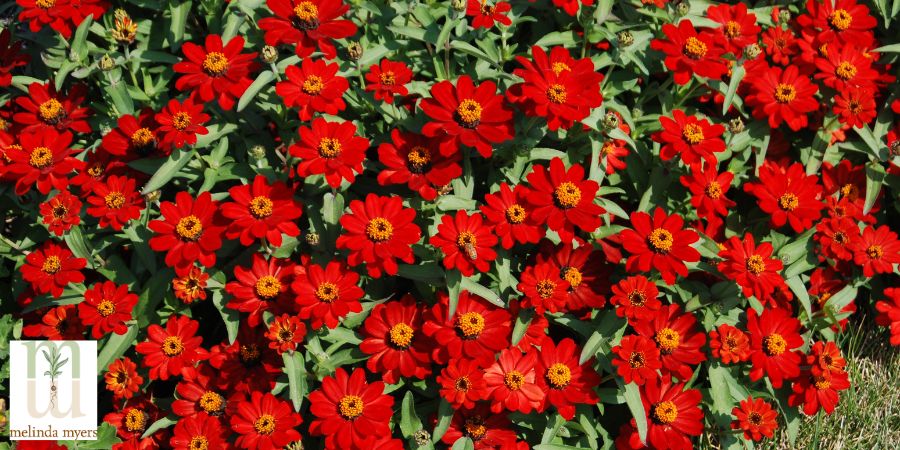
Red Zinnias in the garden
-Calibrachoa hybrids often called Million Bells are tender perennials usually grown as an annual in full sun and well-drained soil. These thrive throughout the season and are covered in blooms that are available in a variety of colors. Deer usually pass by this plant but hummingbirds have been known to visit the flowers.
-Vermillionaireâ cuphea is one of my favorite hummingbird plants. Often called firecracker plant this common name was inspired by the orange tubular flowers tipped in yellow. It thrives in full sun, tolerates heat and drought and requires no deadheading to flower all season long.
-Angelonia sometimes called summer snapdragon is heat, drought and full sun tolerant. You can find it in a variety of heights and colors. Use a few in containers or plant a mass of them in the garden for an impressive summer long display.
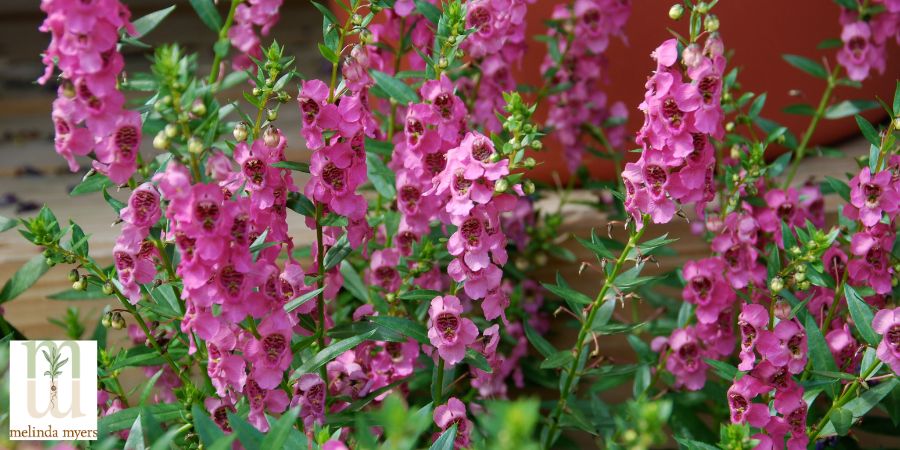
Pink Angelonia plant in the garden
-Diamond frost euphorbia is another heat and drought tolerant plant. The light airy flowers and foliage remind me of baby’s breath, but it is much easier to grow and always looks its best. I find you can combine it with just about any drought tolerant plant you are growing in containers and garden beds.
-Sweet alyssum’s easy-care nature and fragrant flowers have helped it remain a popular garden plant. It enjoys full sun and cooler temperature helping to extend the season from spring through fall and throughout winter in milder locations. Consider purchasing Snow Princess or Blushing Princess if you need a more heat tolerant and vigorous variety for your summer garden.
-Begonias like the Dragon Wing, Whopper and Big thrive in sun or shade and need no deadheading to look good and flower all season long. Most are hardy in zones 9 to 11 but if you are in a colder region like me, you can try overwintering them indoors. I have had success growing a few pots of these indoors in a sunny window over the winter. I am often rewarded with a few flowers before moving them back outside in spring once the danger of frost has passed.
-Coleus varieties come in a variety of sizes, colors and leaf shapes. Check the tag for preferred sunlight conditions when purchasing them. Some varieties thrive in full sun while others need the shelter of some shade. Look for those that are described as compact and flowering late in the season. This reduces or eliminates your need to clip off the flowers and pinch back the plants to keep it looking neat and tidy.
-Impatiens are a favorite of shade gardeners thanks to the season long color they provide without the need to deadhead. Plant downy mildew resistant varieties like Bounce, Beacon, Sunpatiens or New Guinea to avoid losing your planting to this disease. You will find a variety of colors, even a few double flowers and sizes as well.
Perennial Flowers & Grasses That Are Easy to Take Care Of
With proper selection and care these plants will provide years of enjoyment in your landscape. Avoid aggressive growers that need frequent division to keep them in line.
-Blue False Indigo (Baptisia australis) is an easy-care native perennial. The large, long-lived plant develops a deep tap root making it more drought tolerant. The spires of blue flowers top blue-green leaves in early to mid-summer. Black pods follow extending the beauty and add the sound of wooden chimes to the winter garden. It is a host plant for several caterpillars, hardy in zones 3 to 10, grows best in full to part sun and tolerates a variety of soils.
-Garden Phlox (Phlox paniculata) are tall summer bloomers with great hummingbird and pollinator appeal. Select varieties that are known for their disease resistance like David and Glamour Girl. Jeana and Laura garden phlox varieties also have good disease resistance and are fragrant. Plant this in a location with full to part sun and moist well-drained soil. Hardy in zones 4 to 8 you can extend their long bloom period, if desired, with a bit of deadheading. I choose not to and still enjoy lots of color from my garden phlox.
-Prairie dropseed (Sporobolus heterolepsis) is a native grass that adds year-round interest to any formal, informal or natural garden. This grass forms clumps of narrow leaves about 2 feet tall. The narrow green leaves turn beige to deep orange in fall and persist all winter long. Flowers appear and sway above the leaves in fall, providing a hint of buttered popcorn or coriander in the area. Seeds persist in the winter and look like gems when ice-covered and glistening in the sun. Hardy in zones 3 to 9 it prefers full to part sun, well-drained soils, is drought tolerant once established and deer resistant. Be patient as it can be slow to establish but the wait is worth it for this long-lived perennial.
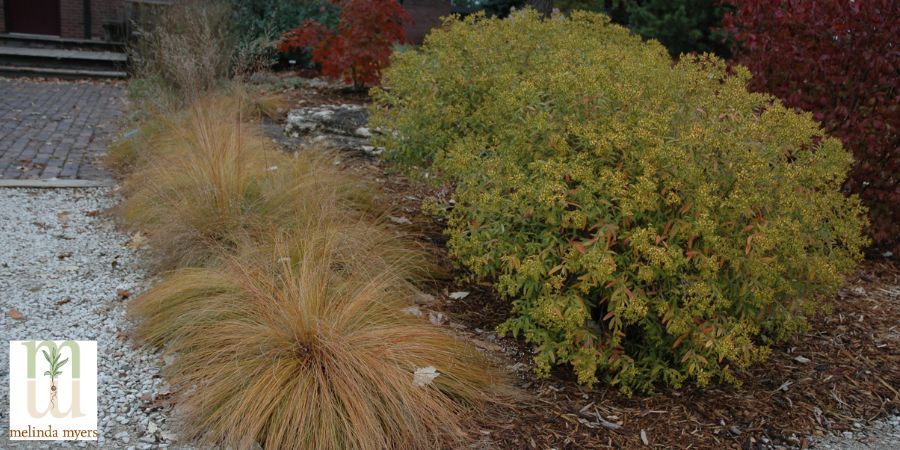
Prairie Dropseed native grasses in a landscape
-Catmints (Nepeta x faassenii cultivars & Nepeta hybrids) described as clumping or non-spreading are good choices for hot dry locations without overtaking the garden. The spikes of blue flowers provide a long season of color and are held above a mound of gray-green leaves. New cultivars like Cat’s Pajamas, Cat’s Meow and Junior Walker are not aggressive and are less likely to flop and need a mid-summer haircut. Check tags and descriptions to find the catmint that best fits your garden. Depending on the species you will find catmints hardy in zones 3 to 9.
-Calamint (Clinopodium nepeta nepeta – formerly Calamintha nepeta nepeta) is a tame member of the mint family. This subspecies does not reseed readily, so it won’t take over the garden bed. Enjoy several months of white airy flowers and a season of lemony-mint fragrant leaves with this plant. You’ll do minimal maintenance, once established, for this full sun, hot, and dry weather tolerant plant that is a bee favorite. Look for this zone 5 to 9 hardy perennial in your local garden center.
-Sedums come in a variety of sizes, growth habits, leaf colors and bloom times. Grow them in full sun and well-drained soils for the best flowering and growth habit. Some sedum varieties add fall color to the garden and the persistent seed heads of late bloomers add winter interest to the garden. Watch for the butterflies that stop by for a sip of nectar. Select varieties that complement your garden design and are hardy in your area.
-Daylilies (Hemerocallis species and hybrids) are durable plants that can provide a month or more of flowers. Each flower only lasts a day, but each flowering stem can contain up to 30 flower buds that open a day at a time. There are also repeat blooming varieties that send up a several flushes of flowers throughout the season. If the faded flowers annoy you place the plants in a full to part sun location where you can enjoy the color but not be distracted by the flagging blooms. That’s what I do. Or follow my friend’s advice and enjoy a glass of your favorite beverage as you deadhead the plants. I chose to enjoy the beverage and the view my daylilies from my porch. You’ll find daylilies that are hardy in zones 3 to 9.
-Lenten Rose (Helleborus x hybridus) adds colorful blooms to the landscape in late winter or early spring. These perennials do well in light to moderate shade and come in a variety of colors as single or double flowers. The colorful sepals are long lasting, and the leaves look good all season long and are evergreen in milder climates. Plant them in rich moist soils for best results in zones 5 to 9.
-Coral bells (Heuchera species and hybrids) are low growing perennials that add color to sunny and shady areas in the landscape. Their colorful leaves combine nicely with a wide array of plants and the wands of bell shaped flowers attract bees, butterflies and hummingbirds. Check the tags to match the ones you select to the sunlight conditions in your landscape. You’ll find a wide selection of varieties hardy in zones 3 to 9.
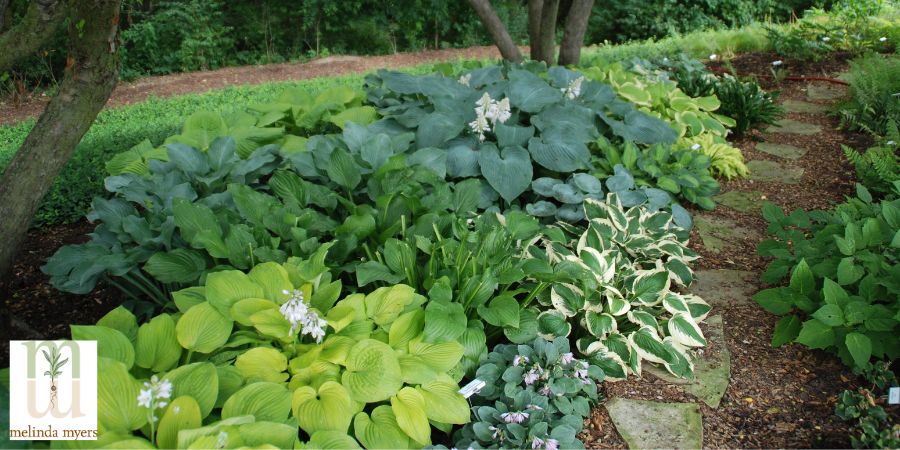
A variety of Hostas in a landscape.
-Hostas have long been a favorite of shade and low-maintenance gardeners. The flowers attract hummingbirds and seeds if left on the plants feed visiting juncos. Create a garden of various hostas or combine them with other shade-loving plants like Annabelle-type hydrangeas, Solomon seals, ferns, and Siberian bugloss (Brunnera).
Switchgrass (Panicum virgatum) forms an attractive but very large stand, making the clump-forming cultivars more suitable for most home landscapes. This tall upright grass comes in varieties from 2 to 6 feet tall. The fine foliage of green or blue-green turns yellow-orange in the fall and are host to several caterpillars. The cloud of flowers appears in late summer or early fall and the seeds persist through winter providing food for birds and small mammals. Grow this grass in full to part sun and moist soil. It does tolerate occasional wet and dry periods and is hardy in zones 3 to 10, depending on the variety.
Easy to Grow Indoor Plants
Take your low maintenance gardening strategy indoors with these easy to grow indoor plants. Enjoy your indoor garden with minimal care by matching the plant to the available sunlight and your plant watering habits.
-Snake plants (Dracaena trifasciata formerly Sanseveria trifasciata) have long been valued for its easy-care nature and tolerance to low light. The upright leaves can be solid, variegated, marked like a snake’s skin and available in different heights. Snake plant does grow best in bright locations but adapts to a variety of sunlight situations. Water thoroughly and allow the top few inches of soil to dry before watering again. Overwatering is the biggest cause of death in this plant.
-ZZ plant (Zamioculucas zamiifolia) is another low maintenance indoor plant you often see used in shopping malls, airports and similar locations. The cluster of upright stems feature elliptical shaped leaves. Grow this in low light situations, water thoroughly and allow the soil to dry before watering again. Those in zones 9 and 10 can also grow it as an evergreen outdoor plant.
-Cast iron plant (Aspidistra elatior) certainly lives up to its common name as this easy-care plant takes lots of abuse and keeps growing. The 2’ tall clumps are used as a shade tolerant groundcover in zones 7 to 11 and make an excellent low light houseplant everywhere. Grow it in a well-drained potting mix and water thoroughly when the soil is dry.
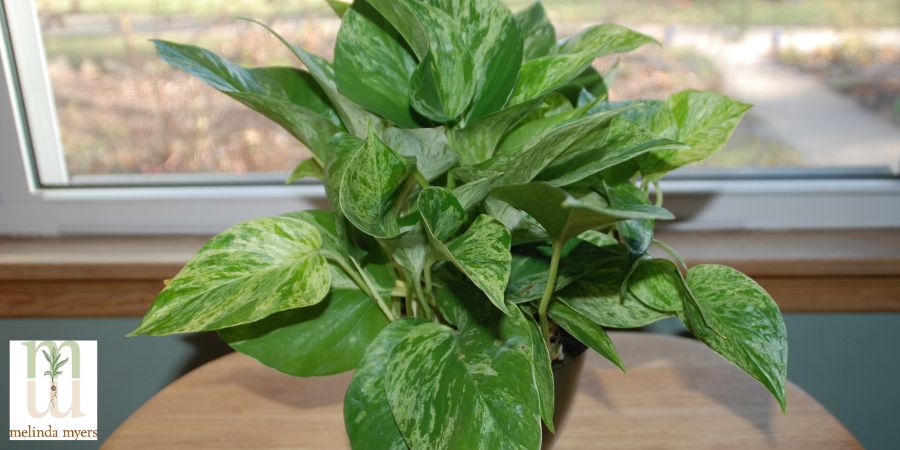
Pothos plant indoors
-Pothos and Philodendrons are long time low maintenance favorites that have experienced renewed interest thanks to the many new introductions. You will find trailing and upright varieties and some with variegated or colorful leaves adding a fresh look to your indoor garden and this group of plants. Grow these in bright indirect light and allow the top inch or two of soil to dry before watering again.
-Spider plant (chlorphytum comosum) is an adaptable houseplant that prefers moderate light but will tolerate lower light conditions. The tufts of long narrow leaves may be solid green or striped. The plant eventually sprouts long stems with small plants at the ends. These can be used to start new plants. Don’t fret if the tips turn brown. This is a common problem caused by the chlorine and fluoride in tap water. Tolerate the damage, the plant will, or use rainwater, distilled water or melted snow to avoid this problem.
-Air plants (Tillandsia species) make fun and easy additions to just about any location. Set them in a terrarium, hang them from a shell, display them on a board or grow them in a container of potting mix. The possibilities are endless. Place these plants in bright indirect light. Many gardeners regularly mist the plants but a weekly soak will also work. My air plants are growing in the north window of my bathroom. They enjoy the extra humidity every time we shower and a weekly soak in tepid water.
-Cacti and succulents are the best choice for busy gardeners and those that tend to underwater their plants but have lots of sunlight. You will find a variety of these drought tolerant sun-loving plants suitable to grow in dividual pots, open terrariums or in attractive groupings in dish gardens.
Easy to Care For Trees & Shrubs
Trees are excellent plants that can provide beauty year-round and long-term structure in the landscape. They also help conserve energy, provide welcome summer shade, and manage stormwater. Make sure the trees you select are suited to the growing conditions, do not create a mess and will fit the space when they reach their mature size.
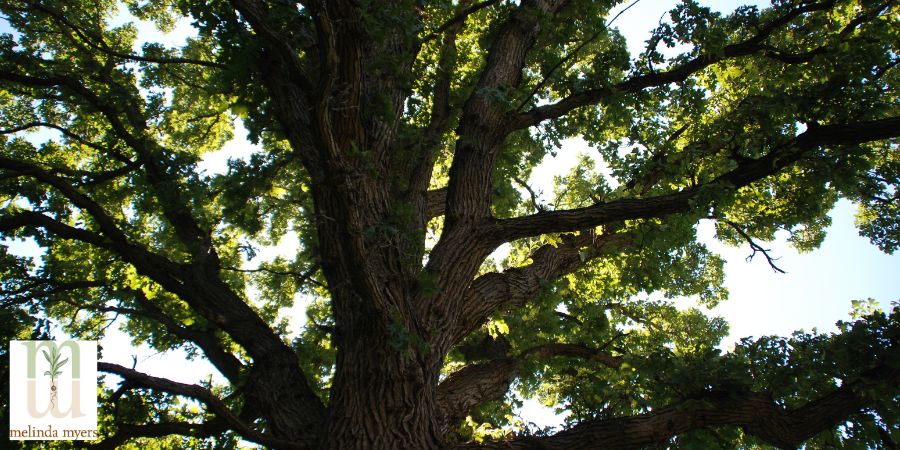
Water and mulch are key to keeping trees healthy. Water newly planted trees whenever the top 4 to 6 inches of soil are crumbly and moist. Provide trees with 10 gallons of water for every diameter inch of the trunk at 4 ½ ft high. Mulch the soil surrounding the tree with several inches of woodchips or shredded bark to help conserve water, suppress weeds, and improve the soil as they break down. Pull the mulch away from the trunk to avoid rot and reduce the risk of vole damage. Create as large a mulch bed around the tree as you can tolerate. Keeping grass away from your young tree reduces the competition for water and nutrients that can slow the tree’s growth.
Use shrubs to provide structure and year-round beauty in your landscape with less maintenance. When working for the City of Milwaukee Bureau of Forestry, we gathered data and evaluated the time and money spent maintaining trees, shrubs, turf, and flowers. Shrubs required the least amount of care once established. Minimize pruning and maintain their beauty by selecting shrubs that will fit the space once they reach their mature size. Once again, look for those that provide seasonal interest, support pollinators, and songbirds, and are suited to the growing conditions. Mulch and water thoroughly when the top 4 to 6 inches of soil are crumbly and slightly moist to help establish a robust root system better able to access water from a larger area during dry weather.
Wait a year after planting to fertilize trees and shrubs. Milorganite is a good choice as it promotes balanced above and below ground growth and will not harm developing roots. Consult an expert if needed for pruning advice. New plantings need minimal pruning but as they develop proper pruning, especially on young developing trees can help create and maintain a strong framework. This reduces the risk of storm damage and minimizes ongoing care to keep them healthy and looking their best.
Add more seasonal color and bird and pollinator appeal with a few of these and other easy-care flowering plants for your outdoor spaces. As always select plants suited to your growing conditions.
As you create and expand your landscape, look for plants that thrive in the existing growing conditions and with the care you are willing and able to provide. This will increase your success and enjoyment and help you avoid failure and frustration that can occur when we select the wrong plants for our gardens and gardening style.

